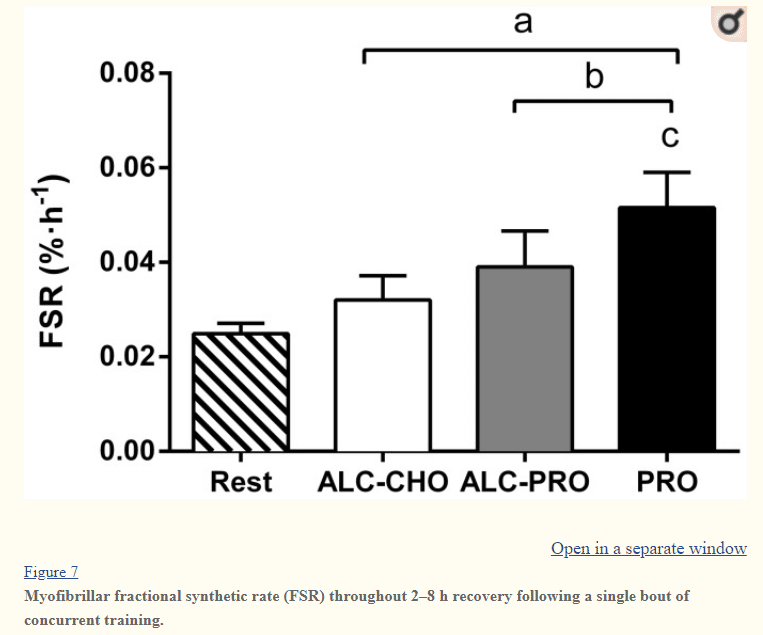
☆163:トレーニング(筋肉)とたんぱく質<出典情報>
<参考書籍>
「運動・スポーツ栄養学 第4版 (栄養科学シリーズNEXT)」
中村 亜紀 (編集), 青井 渉 (編集), 加藤 秀夫 (編集), 中坊 幸弘 (編集)
「女子栄養大学のスポーツ栄養教室」
上西 一弘 (著)
「新版 筋トレと栄養の科学」
坂詰 真二 (監修), 石川 三知 (監修)
「スポーツする人の栄養・食事学 (集英社新書)」
樋口満 (著)
「眠れなくなるほど面白い 図解 たんぱく質の話」
藤田 聡 (監修)
<その他>
・3食均等にたんぱく質を摂取した方が、夕食に偏って多く摂取した場合より筋たんぱく質合成速度が高かった。

Randomized Controlled Trial J Nutr. 2014 Jun;144(6):876-80.
Dietary protein distribution positively influences 24-h muscle protein synthesis in healthy adults
protein at breakfast, lunch, and dinner distributed evenly (EVEN; 31.5 ± 1.3, 29.9 ± 1.6, and 32.7 ± 1.6 g protein, respectively) or skewed (SKEW; 10.7 ± 0.8, 16.0 ± 0.5, and 63.4 ± 3.7 g protein, respectively)
・85%糖質食よりも64%糖質+たんぱく質の混合食で筋肉グリコーゲンが有意に増加した。

J Appl Physiol (1985). 2002 Oct;93(4):1337-44.
Early postexercise muscle glycogen recovery is enhanced with a carbohydrate-protein supplement
The three different nutritional supplements were carbohydrate + protein (CHO-Pro), a commercial product (Systems GO International) containing 378 kcal [240 kcal (80 g) of carbohydrate + 84 kcal (28 g) of protein + 54 kcal (6 g) of fat]; HCHO containing 378 kcal [324 kcal (108 g) of carbohydrate + 54 kcal (6 g) of fat]; and LCHO containing 294 kcal [240 kcal (80 g) of carbohydrate + 54 kcal (6 g) of fat].
・たんぱく質のみ、糖質のみを摂った時より、両方を同時に摂った方が筋肉の回復が早い。
J Appl Physiol (1985). 1992 May;72(5):1854-9.
Carbohydrate-protein complex increases the rate of muscle glycogen storage
・トレーニングによる筋肥大効果は、運動の直前直後にたんぱく質を摂取した群で大きい。その効果は速筋繊維で顕著である。

Med Sci Sports Exerc. 2006 Nov;38(11):1918-25.
Effects of supplement timing and resistance exercise on skeletal muscle hypertrophy
・プロテイン単独よりアルコール+プロテインで筋トレ後2~8時間の筋たんぱく合成が有意に減少していた。

PLoS One. 2014 Feb 12;9(2):e88384.
Alcohol ingestion impairs maximal post-exercise rates of myofibrillar protein synthesis following a single bout of concurrent training
Rates of muscle protein synthesis
Rates of myofibrillar FSR were increased above rest (0.025±0.002%·h−1) with ALC-CHO (0.032±0.005%·h−1, ∼29%), ALC-PRO (0.039±0.008% h−1, ∼57%) and PRO (0.052±0.008%·h−1, ∼109%) treatments throughout 2–8 h of recovery (P<0.05; Figure 7). However, compared to PRO alone, there was a hierarchical reduction in myofibrillar FSR with ALC-PRO (24%, P<0.05) and ALC-CHO (37%, P<0.05). ALC-CHO resulted in a lower FSR compared to ALC-PRO (∼18%, P<0.05).
